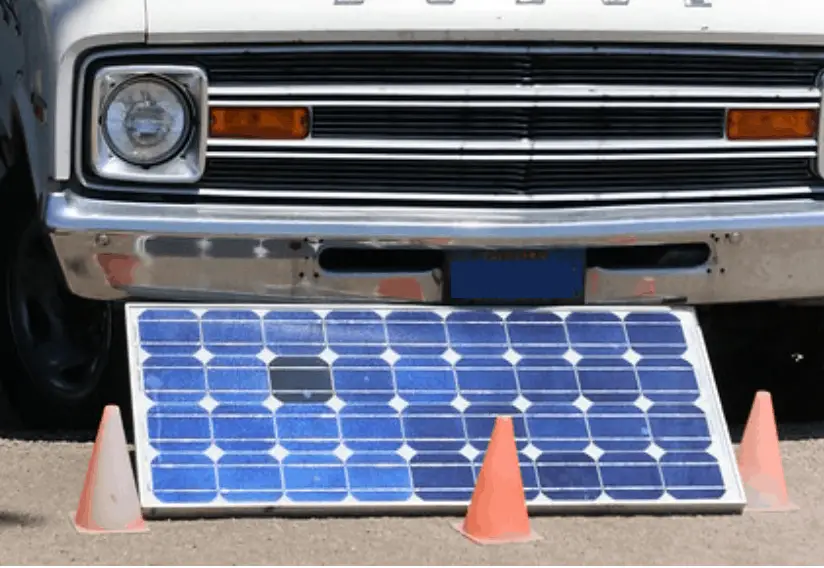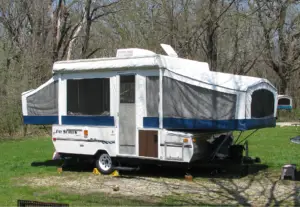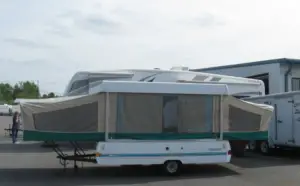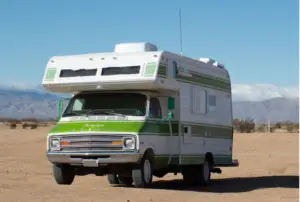Have you been thinking of how to use solar to charge your RVs battery? Getting solar on your RV can solve a lot of your problems and also help save a lot of money.
In this article, lets check out how you can do the solar setup and keep your RV batteries charged using a free solar energy.
Charging the RV Batteries Using Solar Panel
Yes, RV batteries can be charged using solar energy or solar panels. And its easier than most people think. In a simple assembly one can simply put the panels on top of the RV and get them hooked directly to the battery via a controller to get them charged.
No, you cant use solar panels to run your appliances directly. That’s a common misconception about solar panels in RV. You have to store the energy in batteries and then use it.
You can either use it to power your DC operated appliances like lights or even the AC powered ones via an inverter.
There are multiple ways how you can do the set up. First, lets check on a simple way with minimum cost and efforts.
I know there will be lots of question here. How big of a panel, 1 panel or multiple? Where to place it, should it be permanently installed and so on.
But, hang on.
All you question will get answered if you read through the entire article. If not, all at-least you will have the basic idea on where to start and whats it going to be.
Let me give you an example on what we did on our very first instance of using solar to charge the batteries.
We got a solar panel from a shop, (it was inexpensive and was rated at around 100 W). It came with a cable or wire that had clips on either ends. One cable was red and the other was black. Negative and positive, that’s right.
The simple thing here was to connect the one end to the solar panel and the other to the battery terminal via a controller. One can also connect the solar panel output to the battery but with that you will be putting batteries at risk. The solar output if goes beyond whats needed for battery can heat them and destroy their capacity to hold charge.
Also, even a smaller panel can heat the battery if connected directly. So, have to be careful about this and avoid doing it.
Placing the panels for maximum sun exposure
So, yes it was as simple as it. Now, we did a few things to make it actually work. As you already know, you need the panels to face the sun. Therefore, you cant just keep the panels anywhere.
In our case, we identified that we had to keep them on roof for better sunlight accessibility. But, the problem was with cable or the cord that came with it. Since it was an inexpensive one, it was not that long to reach the battery from the roof.
The next thing what we did was cut the cable in between and extended it by using other wire. We preferred using the same clips on either ends because that’s what is better to do.
The clips are specially made for that and also holds the terminal well. So, that was it with the extending the connection cable or wire.
Trickle Charging
In our case we didn’t do the installation permanent as we would use it only while camping. Also, we had other source to charge the battery. The solar panel was used to trickle charge the battery.
This method is best suited for trickle charge only, as it will take many hours to get the battery charged. But, this method is great to keep the battery charged for longer time. You cant just keep running that generator for hours again to keep them charged. Solar panel is a great enhancement to your other charging sources.
Read : Solar vs Generator For RV
The whole solar panel idea is for those who go boondocking or dry camping often. Otherwise, one can use the shore power to keep the batteries charged anyways.
Solar Panel Kits
We go camping without shore power and it makes sense to have a solar charging facility for us. The method we saw above is the basic, one can follow otherwise there are solar kits that come as well. The solar panel kits can make the whole battery charging process easy and better. We will see how the solar kits work and how to install them.
Getting the solar panel kit

The other way to get the whole set up done is to simply buy the special kit for this. This will be costlier approach. It will have the solar panels with installation assembly that can be permanently fixed on your RV roof.
It will also come with long enough connection cable cord with clips on either ends. The quality will depend on the brand you choose. But, the kit will be to enable you to use it on the roof. There will be charger controller in between the battery and the panels.
One end will be connected to the controller and from controller the battery would be charged. More sophisticated kits will also have apps connected via Bluetooth to the controller. You can then monitor the battery charging on the app itself. In other cases, you can access the battery charging information on the controller.
The solar panels can be tilted using the tilting legs. For installing the panels on roof, first you have get them hooked to the back-end board it will come with. And then, you have to fix the panels using screw on the roof.
Make sure you use seal like decor to close the holes or screws to make sure there wont be any leaks.
Try smaller First
The solar kits usually cost more than $500 – $600 and even more depending on the size of the panels you opt for. If this is going to be your first time then its better to keep it simple and go smaller.
You can always increase the capacity by connecting more panels in series or parallels. Its always better to start small and then expand once you are comfortable with the setup, Otherwise if things do not work for you then the whole efforts will go in vain.
Have to be Flexible with Placing the Panels
There can be many issues initially, like unable to get the sunlight on the solar. And other issue that you will learn once you start with it.
In our case, we found that keeping the solar panels only on roof wasn’t great. The roof would be covered in shade and then it wasn’t efficient there. So, we unscrewed two of our panels and got them down. We would keep them on the ground and connect them with the controller.
This way we had both options of keeping them up on the roof as well as move them as per sunlight.
Therefore, its always better to start smaller and try things until you figure out the best for your. Getting a big sophisticated panel that can cost in thousands can turn out to be mistake.
Other important thing is to beware of your region. You should have the sun out most of the times. Like in California we have good sun that comes out all the time and we don’t face much issues with getting the sunlight. This may not be the case in other states.
Time taken To Charge Battery
Charging the batteries can take hours. When you put it for charging using the generators, it can take more than 5-8 hours or even more. The whole thing with the batteries is, it take can any number of hours depending on the battery.
Usually, when the battery is down at 50% it will charge up to say 60-80% quickly but will take much longer to go upto 90% and 100%.
The battery will take as many hours as it may want to. Its not fixed, it will depend on how the battery behaves, charges and consumes the current.
As far as solar is concerned it will trickle charge your AGM or deep cycle battery and supplement it for charge that you can use. The primary charging source has to be generator or shore power.
So, why cant one simply use the generator to charge it when its down. There are two reasons why we avoid it.
- Generator is a noise that you don’t want.
- Generator uses fuel
Solar has initial cost and installation and after that its free. So, having this setup can actually save a lot of money over time. People who do full time in RV for them its a great way to keep up the battery charged and save over long time.
Running the generator for 2-5 hours to get the battery charged for 10-15% can be harsh on your hears. Having solar trickle charge the battery whole day can therefore be a great way to escape the noise and save fuel.
We know few of our friends who still prefer generator to charge the batteries while camping. Having a small generator which makes very less noise can work for some people. Here are some quite and portable generators that you can buy for your RV.
Solar way of charging is for those who can adjust themselves for the setup.
How many solar panels you need?
Solar panels come with different ratings that can be 10 W, 100 W and even more. The higher the watts rating larger will be its size. A 100 watt panels will be standard size that can be used and installed easily.
So, how many 100 watts panels do you need? It will depend on two factors,
- How many amp hours do you use in RV per day
- Whats the capacity for your battery
Your usage in terms of amp hours will depend on how many watts are being consumed for the day. That again will depend on the appliance watts and how many hours its begin run.
Watt-hours = watts * hours
So, to get amp-hours from watt-hours, you use:
Amps hours = Watt-hours ÷ Volts
Like, for example if you have an light that consumes around 60 watts and runs for 6 hours at 12V then your amp hours will be 30 Amps hours.
Calculating this way you need to know your entire days amp hour consumption. A typical 12 V RV battery can give 200 amp hours. It can be less as well, it depends on the battery type whether you have lithium or AGM or lead acid.
You need to have fair idea of whats your consumption and what your battery can store. In this way you get to a number that you would want to produce with the solar panels.
So, say you have a 100 Watts panels and it gets sunlight for say 6 hours, it can produce about 5 amps per hour. With this rate, the overall output would be close to 30 amp hours.
Solar panels are fairly efficient but since the sun may not be hitting the panels consistently we can see a drop in about 20-30% efficiency. You should be able to get close to around 30 amps with one 100W panel and can multiple it with more panels as needed.
If your usage of day stands at around say 140 amps hour then try getting 4-5 solar panels of 100 watts.
Knowing whether the battery is being charged or not
As we already saw, one can make use of controller to monitor the battery charge. You can also make use of multi-meter or voltmeter to see if the battery is being charged or not.
More sophisticated kits will give you option of app to monitor the whole charging process. If you are full time RVing then getting such a system makes sense. You don’t have to struggle to see whats happening with the charging.
The controller in some assembly is placed on the panel holding legs that helps in keeping the panels tilting or standing for better sunlight capture. In some cases the controller would be near the battery.
Charging Issues
If you see that the battery isn’t charging then it could be an issue with the wiring or the battery itself.There could be loose wiring between the battery and controller or with the battery.
Issue can also be with the controller setting. If the voltage itself is not getting generated from solar panels then the panels could have gone bad or the rectifier diode assembly could be faulty.
Read : Why my RV battery wont charge
Generally, with popular products once you do the setup you wouldn’t find such issues unless it became old or was subjected to physical damage.
Do you really need to go solar?
So, after disusing all the in-and-outs we are at the most basic question again. Do you and should you really go the solar way? Well, the answer lies with you my friend.
Like in our case, we had the best scenario to make use of the panels. We didn’t had the option of shore power and therefore were dependent on battery power much more.
Having a generator is necessary but the noise that it makes can be a difficult thing to tolerate. Also, running it for hours to keep up the batteries could be avoided if you make use of solar the right way.
Solar is free and that’s an added advantage. You need to adjust yourself for using solar. Just installing them on the roof may not work. You will have to position the RV, or get the panels out from the roof and place them on the ground. Also, sun may not be there always to provide for the power.
These are some of their cons you need to consider.
But, most people who use solar will agree that it makes your life much easier while dry camping or boondocking. You have to start using the solar and in the process understand your need and get the whole solar panels system ready for usage.
In Conclusion
Using solar panels in RV is a very good way to save in long run. Its an awesome way to keep your batteries charged for the rest of night. Setting up solar initially can be little hard but once you get it done, you can camp without worrying.





